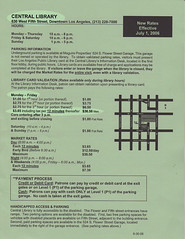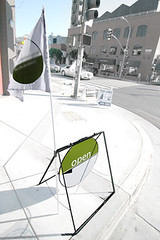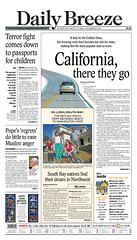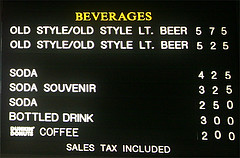New home sales increased nationwide in August. However, prices are lower than they were a year ago.
CNN is the first online with coverage on the new numbers.
Email
Independent reporting and commentary from TJ Sullivan, a national award-winning writer, formerly of Los Angeles, now living in Chicago. Sullivan is an author, independent journalist, photographer and college-level journalism instructor who has been featured as a speaker at several national writing conferences. To request an interview, or to inquire about scheduling Sullivan to speak at your event, please include the name and address of your organization and a contact telephone number.
Wednesday, September 27, 2006
Monday, September 25, 2006
LA's 10 Richest Residents
Forbes has released its list of The 400 Richest Americans. The top 10 in Los Angeles are:
Email
1. Kirk Kerkorian
Overall Rank: 26, $9.0 billion, 89 years old, investments, casinos
2. Eli Broad
Overall Rank: 42, $5.8 billion, 73 years old, investments
3. David Howard Murdock
Overall Rank: 59, $4.2 billion, 83 years old, investments
4. Patrick Soon-Shiong
Overall Rank: 77, $3.4 billion, 54 years old, generic drugs
5. Ronald Burkle
Overall Rank: 117, $2.5 billion, 53 years old, supermarkets, investments
6. Alfred Mann
Overall Rank: 140, $2.2 billion, 80 years old, inventor, entrepreneur
7. Michael Robert Milken
Overall Rank: 153, $2.1 billion, 60 years old, investments
8. David Whitmire Hearst Jr
Overall Rank: 160, $2.0 billion, 61 years old, Hearst Corp
9. George Randolph Hearst Jr
Overall Rank: 160, $2.0 billion, 79 years old, Hearst Corp
10. Anthony Pritzker
Overall Rank: 160, $2.0 billion, 45 years old, hotels, investments
National Median Price Falls For 1st Time in 11 yrs
The national median price on previously owned homes fell in August, the first time it's done so in 11 years.
From The New York Times:
Email
From The New York Times:
The National Association of Realtors reported today that existing home sales dropped 0.5 percent from July to August to a seasonally adjusted annual rate of 6.3 million units. That compares with a decline from June to July of 4.1 percent.From the Los Angeles Times:
On a regional basis, the West was the only part of the nation in August to report an increase in the median sales price, a meager 0.3% rise to $345,000. Sales, meanwhile, fell 2.3%.From the California Association of Realtors:
Home sales decreased 30.1 percent in August in California compared with the same period a year ago, while the median price of an existing home increased 1.6 percent, the CALIFORNIA ASSOCIATION OF REALTORS® (C.A.R.) reported today.
“We experienced the greatest year-to-year sales decline last month since August 1982, when sales fell 30.4 percent,” said C.A.R. President Vince Malta. “This is another indication that we’re in the initial stages of a long-anticipated adjustment in the market.
“Buyers today have a much greater selection of properties from which to choose, while some sellers are still clinging to price expectations that are no longer valid in today’s market,” he said.
Tuesday, September 19, 2006
My $36.50 Parking Education
I've been doing a lot of research this month at the Central Library downtown, and thought I'd figured out the parking situation.
And then came the $36.50 bill.
I'd spent more than four and a half hours in the stacks, and so, of course, I should have been punished. But $36.50?
This might be a hint as to why it seems few people use the library downtown.
— TJ Sullivan in LA
And then came the $36.50 bill.
I'd spent more than four and a half hours in the stacks, and so, of course, I should have been punished. But $36.50?
This might be a hint as to why it seems few people use the library downtown.
— TJ Sullivan in LA
Builder Confidence Lowest Since Feb. 1991
The latest National Association of Home Builders/Wells Fargo Housing Market Index says builder confidence is at its lowest level in 15 years.
NAHB Chief Economist David Seiders offered the following analysis in a press release:
Email
NAHB Chief Economist David Seiders offered the following analysis in a press release:
“Builders are adopting an increasingly cautious attitude in their near-term outlook for new-home sales,” said NAHB Chief Economist David Seiders. “They’re experiencing falling sales, rising sales cancellations, and increasing inventories of unsold units. And although many builders are offering substantial incentives to bolster sales and limit cancellations, many potential buyers now are waiting on the sidelines to see how the market shakes out before proceeding with a home purchase.The HMI follows an adjustment issued earlier this month by the National Association of Realtors, which said home sales will fall about 8 percent in 2006.
“We are in the midst of an anticipated adjustment period as the housing market subsides from the record-breaking and unsustainable highs of the past few years,” Seiders noted. “Our forecast projects the numbers flattening out around the middle of next year and gradually moving back up towards trend in 2008.
“That said, long-term housing fundamentals will be very favorable,” he added. “In fact, the housing market that emerges from this correction will have better balance between supply and demand and will be able to ride on excellent underlying fundamentals for years to come.”
Monday, September 18, 2006
Housing Starts Report Due Tuesday Morning
Housing starts likely fell in August, says Bloomberg.com:
Email
The Commerce Department is scheduled to release the housing starts report at 8:30 a.m. in Washington. The Labor Department will put out the producer prices report at the same time.* UPDATE: Housing starts drop, inflation tame, says Bloomberg.com
Estimates for housing starts ranged from 1.62 million to 1.85 million at an annual rate. Total PPI forecasts were from a drop of 0.1 percent to an increase of 0.9 percent.
Sunday, September 17, 2006
Signs On The Dotted Line
This week's addition to the Signs on the Dotted Line gallery.
Intersection suggestions welcome.
— TJ Sullivan in LA
Intersection suggestions welcome.
— TJ Sullivan in LA
Say Goodbye To California
Interesting numbers piece about outward migration on today's front page of the Daily Breeze. The subhead hints at the reason people want to leave: "Housing costs have become too rich for many…"
The nation's most populous state, a traditional magnet for throngs of daring, ambitious people seeking everything from gold nuggets and great weather to good jobs and Hollywood glamour, now carries an unflattering designation.Email
The Golden State is No. 1 in outward migration of residents to other states, according to the most recent figures provided by the U.S. Census Bureau.
From July 1, 2004, to July 1, 2005, the net flow of residents from California to other states -- those moving to the state minus those leaving -- was negative 239,000 people. That's higher than any other state in the union.
California even edged out former No. 1 New York by 7,000 people.
[CUT...]
As of last year, the state's outflow was at its highest point since the mid-1990s, when a severe recession and aerospace industry slump drove engineers and other professionals out of California in search of work.
Thursday, September 14, 2006
Random Photo
I was downtown this weekend to do some research at the library. I took the camera with me on Sunday and, as there was a race going on, I decided to shoot for a few minutes.
This one was taken outside the Walt Disney Concert Hall
— TJ Sullivan in LA
This one was taken outside the Walt Disney Concert Hall
— TJ Sullivan in LA
Wednesday, September 13, 2006
Sssssssshhhhhhhhh!
They don't put pay phones in the stacks at public libraries.
The phone at right, for example, is in the parking garage beneath the Central Library in downtown Los Angeles. Talk as loud as you want on this one, nobody in the genealogy, or economics sections is going to hear you.
Put a phone like this between the library stacks, however, and you can imagine the complaints. Editorials would ridicule such a move as patently lunatic, reminding all readers that library silence is a rule at least as old as "cover your mouth when you yawn."
And yet, few of my fellow library patrons seemed surprised Sunday when a woman began to carry on a cell phone conversation at full cell-yell volume in the literature and fiction section on the third floor of the Central Library. Although the woman spoke for more than five minutes at this audible level, not a single "sssshhh" was uttered by those around me. Most people just ducked their heads deeper into their books.
The prevalence of rudeness in our society is nothing new. Stories and studies about it have appeared in US newspapers with increasing frequency during the past few years. The results don't seem to change, but the reporting may be taking a turn.
More and more, stories about rudeness are addressing people's reluctance to confront it.
CBS News produced a hidden-camera report this past week that examined public reactions to rudeness. The gist of the video was that people often walk away rather than speak up. Some told CBS they were not willing to take the risk, although none explained what exactly they feared might happen as a result.
CNN did a story last year in which a theory about this was offered:
Some phone companies, including AT&T and Sprint, provide etiquette advice, but the suggestions are so obvious that they're on a par with reminding an adult not to chew with an open mouth in public. Still, I wouldn't be surprised if somewhere there's restaurant with that posted next to the "no smoking" sign.
— TJ Sullivan
The phone at right, for example, is in the parking garage beneath the Central Library in downtown Los Angeles. Talk as loud as you want on this one, nobody in the genealogy, or economics sections is going to hear you.
Put a phone like this between the library stacks, however, and you can imagine the complaints. Editorials would ridicule such a move as patently lunatic, reminding all readers that library silence is a rule at least as old as "cover your mouth when you yawn."
And yet, few of my fellow library patrons seemed surprised Sunday when a woman began to carry on a cell phone conversation at full cell-yell volume in the literature and fiction section on the third floor of the Central Library. Although the woman spoke for more than five minutes at this audible level, not a single "sssshhh" was uttered by those around me. Most people just ducked their heads deeper into their books.
The prevalence of rudeness in our society is nothing new. Stories and studies about it have appeared in US newspapers with increasing frequency during the past few years. The results don't seem to change, but the reporting may be taking a turn.
More and more, stories about rudeness are addressing people's reluctance to confront it.
CBS News produced a hidden-camera report this past week that examined public reactions to rudeness. The gist of the video was that people often walk away rather than speak up. Some told CBS they were not willing to take the risk, although none explained what exactly they feared might happen as a result.
CNN did a story last year in which a theory about this was offered:
[Lew Friedland, a communications professor at the University of Wisconsin-Madison] … said the public has yet to reach its limit for tolerating cell phone abuse. He sees people more or less resigned to it.Cell phones have been an issue for the LA city librarian since at least 2002 when, according to Board of Library Commissioners meeting minutes, she said she "wouldn’t want to place the staff in a position of confrontation with the public over the use of cell phones." (The matter has since been addressed in the library Rules of Conduct).
"It's like swatting at mosquitoes essentially," he said. "You can get one or two, but if there's a swarm of them around you, you just kind of give up or get out of the way. I think cell phones' use in public spaces is partly having the same kind of effect."
Some phone companies, including AT&T and Sprint, provide etiquette advice, but the suggestions are so obvious that they're on a par with reminding an adult not to chew with an open mouth in public. Still, I wouldn't be surprised if somewhere there's restaurant with that posted next to the "no smoking" sign.
— TJ Sullivan
Monday, September 11, 2006
The American Dream Within Reach In OC
So what if these condos are on the smallish side (between 650 and 1,000 square feet), they're new homes in Orange County for less than $500,000, and you can walk to the ballpark and Arrowhead Pond.
A firefighter quoted in today's Los Angeles Times says he got his place for $379,000:
Email
A firefighter quoted in today's Los Angeles Times says he got his place for $379,000:
The granite countertops, stainless-steel appliances and massive saltwater swimming pool had her intrigued. And when Judy Williams saw the $469,000 sales price and the convenience of being able to pop downstairs for a margarita or stroll across the street to an Angels' baseball game, city life started looking a lot better than suburbia.
[CUT...]
Anaheim firefighter Mike Houghton, 24, will be one of those twentysomethings. Houghton, who lives with his parents in Yorba Linda, bought a one-bedroom overlooking one of the complex's four courtyards for $379,000.
"I'll be able to jog to my fire station," he said.
Sunday, September 10, 2006
Friday, September 08, 2006
National Realtor Outlook 'Least Optimistic Yet'
More today on the housing market's decline in a staff story in the The New York Times and a Reuters story in the
Los Angeles Times. From The NYT:
Los Angeles Times. From The NYT:
The latest report to predict a decline in the housing sector was notable for its source. The assessment from the National Association of Realtors, which has until recently been generally upbeat about the health of housing, was the group’s least optimistic yet.Email
“The boom is cooling now,” said David Lereah, the chief economist for the association, who added that falling home sales have been “a bit worse than we had anticipated.”
The group said that it now expected sales to fall further than it has said in the past — about 7.5 percent this year compared with an earlier projection of a 5 percent decline. It also said it expected prices nationwide to drop during the next few months, instead of appreciating modestly. If that happens, it would be the first time since 1993 that median home prices have fallen in any given month.
The revised realtors’ forecast came on the heels of announcements from KB Home and Beazer, two of the nation’s largest home builders, that profits this year would be lower than initially predicted.
Thursday, September 07, 2006
Exotic Mortgages Bite Some Buyers
Unfortunately, there are probably going to be more stories like this one from MSNBC:
Email
More..."Joe" is a homeowner who did not want to give his full name for this story because he’s ashamed to admit that he soon won’t be able to afford his monthly mortgage payments.
In order to get the $800,000 house he bought early last year in California’s Silicon Valley, Joe got an “option ARM,” an adjustable-rate loan that lets him choose from a variety of payments every month. The smallest payment included no principal and less than 100 percent of the interest due. The unpaid interest was tacked onto the principal, creating “negative amortization.”
This let Joe trade lower payments now for higher payments later. He initially thought his salary would rise along with his home’s value — he was a marketing executive for a small software firm he was confident would be successful. But when a lost deal closed the company and “For Sale” signs popped up — and stayed up — in his neighborhood, a now-unemployed Joe is wondering how he will afford those higher payments when his rates adjust.
NAR Economist Says Flippers Could Get Burned
There was more bad news on the housing market today as one of the biggest home builders in the US cut its profit forcast in response to diluted demand in a slowing housing market. KB Home's CEO says that both new and resale homes are taking longer to sell. From the Associated Press:
Meanwhile, the lack of affordability in Los Angeles again made headlines in the LA Times:
Lereah, however, is optimistic about the big picture for the nation. As reported by Bloomberg.com:
"Our earnings expectations for the third quarter and full year reflect an increasingly challenging housing market, where the supply of new and resale home inventories has built up in recent months in markets that have experienced rapid price appreciation or substantial investor activity, or both, in the past few years," said Bruce Karatz, chairman and chief executive.Bloomberg.com expands on that quote by explaining that Karatz is concerned about "flippers," property investors who may be attempting to exit the market en masse. Bloomberg.com quotes David Lereah, chief economist for the National Association of Realtors, as saying "People who purchased last year with the intent of flipping are likely to get burned."
Meanwhile, the lack of affordability in Los Angeles again made headlines in the LA Times:
The city of Los Angeles has made little headway in expanding the supply of housing for low- and middle-income residents because old affordable units have been destroyed almost as quickly as new ones have been built, according to a new study.I just mentioned the condo conversion issue yesterday in reference to another story about Standard Pacific Corp's decision to pull out of a condo project downtown.
The analysis, to be released today by the Southern California Assn. of Non-Profit Housing, is likely to fuel an increasingly heated debate about housing and gentrification in the city.
Lereah, however, is optimistic about the big picture for the nation. As reported by Bloomberg.com:
"We'll probably see prices dip temporarily below year-ago levels as the market works through a build up in housing inventory,'' David Lereah, NAR's chief economist, said in the report released today in Washington by the real estate industry's largest trade group. He didn't provide a monthly median estimate.Email
Wednesday, September 06, 2006
Another Developer Decides L.A. Too Big A Risk
Yet another indicator of a slowdown in the Los Angeles housing market was reported today by the Los Angeles Times. The LA housing market, and all those adjectives that came with it the past few years (soaring, booming, skyrocketing, etc...) now appears analogous to a pop fly approaching its apex, which raises more questions than it answers. What now? Do prices drop? Do they level off and float? And what about the concerns expressed by many people about the condo conversions that have pulled so many rent-stabilized apartments out of LA's housing pool? Might a slowdown be good news in that regard? No one has the answer yet, but situations like this one seem to offer at least enough fodder for a hearty debate:
Email
Suburban home builder Standard Pacific Corp. has opted out of an agreement to buy a major Los Angeles condominium project, another sign that downtown's once-sizzling condo market might be losing steam.More...
The condo development, adjacent to Union Station, was behind schedule and was having trouble attracting buyers for the units priced in the $600,000 range. Instead of being sold as condos, the 272 units will be leased as apartments beginning today by the project's owner, Lincoln Property Co. of Dallas.
"The delays of getting buyers into the building, combined with the market softening, all conspired to cause us to reach the conclusion we did," Steven Ross, director of planning for Standard Pacific's Los Angeles division, said Tuesday.
Although prices in the downtown market — one of the last in the Southland to heat up and stay hot — continue to rise year over year, sales have slowed considerably while the supply of units continues to grow, creating what some analysts say is a condo glut.
Tuesday, September 05, 2006
Why Does Water Triple In Price At The Airport?
On my recent journey through the Midwest most all the conversations I had with strangers involved not the weather, the war in Iraq, nor the price of gasoline, but rather the cost of water.
Throughout the four flights I took in the past two weeks I encountered dozens joining the water rant, and with good reason. In the past, complaints about the high cost of water in places like ballparks, stadiums, and airports was met with the reply "plan ahead and bring your own next time." But at our nation's airports that's no longer possible.
You can't bring water, or any other liquid, through an airport security checkpoint. That rule forces travelers wishing to stay hydrated to either pay the ridiculous $3 or more per bottle in a terminal snack bar, or wait until the beverage cart works its way down the aisle during their flight. If you arrive two to three hours early for your flight, be prepared to be parched.
For those who break down and make the investment in a bottle, they'll have to drink up before boarding. Once on the plane, flyers are asked prior to takeoff to hand over any liquids they might have accidentally carried on board. On one flight, TSA was in the jetway doing spot searches. At another airport, the window ledge beside the boarding line was filled with half-consumed cups of Starbucks coffee and bottles of water.
There's been plenty of debate about the effectiveness of the security measures. But the matter many travelers harp on is how airport vendors have managed to escape criticism while charging more for a bottle of water than for a soda, or hot drink. What happens to a $1 bottle of water between the convenience store and the airport that causes it to more than triple in price?
Every savvy traveler knows that the price per gallon of gasoline increases at service stations closest to airports (blame the nearby rental car lots). But as pricey as that gasoline can be, it's never three times the cost of gasoline elsewhere in town. Were that the case there'd surely be an outcry, as well as an investigation.
Not so with water, which unlike other beverages is not a luxury, but rather a necessity.
Congress has to be aware of it. They fly the same airports and follow the same rules. But, maybe their bottled water qualifies as a reimburseable travel expense.
— TJ Sullivan
Throughout the four flights I took in the past two weeks I encountered dozens joining the water rant, and with good reason. In the past, complaints about the high cost of water in places like ballparks, stadiums, and airports was met with the reply "plan ahead and bring your own next time." But at our nation's airports that's no longer possible.
You can't bring water, or any other liquid, through an airport security checkpoint. That rule forces travelers wishing to stay hydrated to either pay the ridiculous $3 or more per bottle in a terminal snack bar, or wait until the beverage cart works its way down the aisle during their flight. If you arrive two to three hours early for your flight, be prepared to be parched.
For those who break down and make the investment in a bottle, they'll have to drink up before boarding. Once on the plane, flyers are asked prior to takeoff to hand over any liquids they might have accidentally carried on board. On one flight, TSA was in the jetway doing spot searches. At another airport, the window ledge beside the boarding line was filled with half-consumed cups of Starbucks coffee and bottles of water.
There's been plenty of debate about the effectiveness of the security measures. But the matter many travelers harp on is how airport vendors have managed to escape criticism while charging more for a bottle of water than for a soda, or hot drink. What happens to a $1 bottle of water between the convenience store and the airport that causes it to more than triple in price?
Every savvy traveler knows that the price per gallon of gasoline increases at service stations closest to airports (blame the nearby rental car lots). But as pricey as that gasoline can be, it's never three times the cost of gasoline elsewhere in town. Were that the case there'd surely be an outcry, as well as an investigation.
Not so with water, which unlike other beverages is not a luxury, but rather a necessity.
Congress has to be aware of it. They fly the same airports and follow the same rules. But, maybe their bottled water qualifies as a reimburseable travel expense.
— TJ Sullivan
Saturday, September 02, 2006
AUDIO: Marketing Yourself As A Freelancer
If you weren't able to make it to the Society of Professional Journalists National Convention in Chicago last weekend, you missed an outstanding panel discussion on freelance journalism.
The session, entitled "Marketing Yourself As A Freelancer," was packed full of eager journalists, attendance that served as both a testament to the quality of the panelists, as well as to the level of interest writers have in freelancing.
Audio of entire 60-minute session is available here.
The panel was organized and hosted by Wendy Hoke (inset), the immediate past chair of the SPJ National Freelance Committee, and an advocate for independent journalists. Unfortunately, Wendy will no longer be the chair of the committee, but I have no doubt that she will continue to be a strong and effective voice for the growing number of freelance journalists who pay dues to SPJ.
Joining Wendy on the panel were three accomplished freelancers:
Email
The session, entitled "Marketing Yourself As A Freelancer," was packed full of eager journalists, attendance that served as both a testament to the quality of the panelists, as well as to the level of interest writers have in freelancing.
Audio of entire 60-minute session is available here.
The panel was organized and hosted by Wendy Hoke (inset), the immediate past chair of the SPJ National Freelance Committee, and an advocate for independent journalists. Unfortunately, Wendy will no longer be the chair of the committee, but I have no doubt that she will continue to be a strong and effective voice for the growing number of freelance journalists who pay dues to SPJ.
Joining Wendy on the panel were three accomplished freelancers:
John Ettorre, a Cleveland-based writer and editor with more than 20 years of experience in journalism. Ettore's work has appeared in the New York Times and the Christian Science Monitor.The audio is available here, and when I figure out how to create a podcast, I'll add that as well.
Stephenie Overman, a full-time freelance writer specializing in workplace and health care issues. Overman is also managing editor of Staffing Management magazine.
Sally Lehrman, author of "News In A New America," and an independent journalist specializing in the coverage of health policy, health care and medical technology.
Subscribe to:
Posts (Atom)










